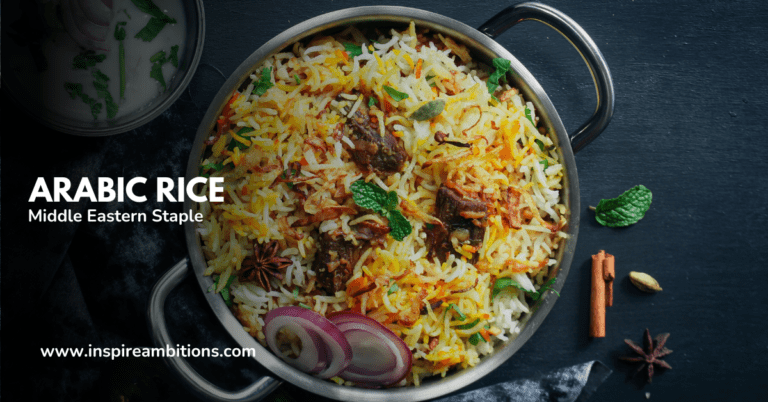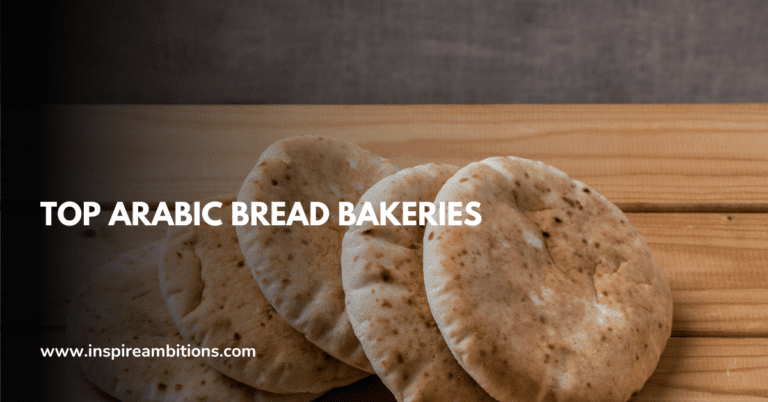Kebab árabe: una sabrosa exploración de la cocina clásica del Medio Oriente
Arab kebab is a popular and flavourful dish that has been enjoyed by many cultures across the Middle East for centuries.
As you embark on your culinary journey to explore the world of Arab kebabs, it’s essential to understand the variety of ingredients and methods used in preparing these delectable skewers.
From ground beef and lamb to an array of herbs and spices, each version can take you on a unique and delicious adventure.
In many Medio este countries such as Lebanon, Syria, and Jordan, kofta kebab is a beloved dish showcasing a delightful mix of ground beef, lamb, parsley, onions, and garlic, expertly spiced with regional herbs.
As you progress further in your exploration of the Arab kebab, you’ll encounter variations in ingredients and preparations, all of which stay true to the rich traditions and unmistakable flavours of Middle Eastern cuisine.
While marinating the meat plays a key role in Arab kebab making, the cooking method is just as critical in achieving the signature taste and texture.
By grilling the kebabs over hot coals or on a Flat Metal grill, you’ll be able to create that irresistible charred exterior while keeping the insides juicy and succulent. So, prepare your papilas gustativas for this flavoursome dining experience as you dive into the world of Arab kebabs.
History of Arab Kebab
You might be curious about the origins of the Arab kebab.
This delicious dish has a rich history stemming from the Middle East. Kebab, originating from the Persian word ‘kabāb’, and Arabic word ‘كباب’, has been influenced by Iranian and Turkish cuisines.
In the 17th century, the word “kebab” reached the English-speaking world through adaptations from Arabic, Hindustani, Persian and Turkish languages.
It is derived from the Arabic word ‘kabāb’, which means “roasted meat.” The basis for kebab dishes can be traced back to the nomadic peoples of Central Asia.
Their meat-heavy diets were adapted to accommodate more vegetables in urban areas where they were readily available.
The Arab kebab has evolved over time, taking on various forms and flavours as it spread across different regions.
You might be familiar with the shish kebab, which consists of skewered and grilled cubes of meat, often marinated in spices and herbs. Another variant is the doner kebab, which features thinly sliced layers of meat cooked on a vertical spit, usually served in a pita bread or wrap.
When preparing Arab kebabs, it’s important to use fresh ingredients and follow traditional cooking methods, such as roasting over an open flame or using a spit roast.
This ensures that you’ll achieve the authentic taste and texture that has been enjoyed by generations.
Now that you have delved into the fascinating history of the Arab kebab, you can appreciate the cultural and culinary significance of this mouthwatering dish.
Next time you enjoy a delicious Arab kebab, remember its storied past and the many hands that have contributed to its evolution.
Ingredients of Arab Kebab
Let’s start.
Meat Selection
For a traditional Arab Kebab, you would typically use about 400g of meat. The meat can be a combination of beef and lamb, which provides a juicy and flavourful base.
Ensure that the meat is finely ground, as this will help in binding the ingredients together when forming the kebabs.
Especias y hierbas
To enhance the flavours of your Arab Kebab, a medley of spices and herbs is essential. Some common ingredients include:
- Cebollas: a small head, finely chopped
- Ajo: 1 clove, crushed
- Mint: 1 tbsp, finely chopped
- Paprika: 1 tbsp
- Lemon: 1, for zesty flavour
Aside from these, other spices you can consider adding are cinnamon, ginger, black pepper, and a pinch of salt.
Additional Components
In addition to the meat and spices, you can also include the following ingredients in your Arab Kebab:
- Bread: for garnishing or serving alongside the kebabs
- Dip: consider a yoghurt-based dip with spices such as cinnamon, ginger and black pepper to complement the dish
Making your Arab Kebab at home is a simple and enjoyable process. By selecting the right combination of meat, spices, and additional components, you will create an enticing and authentic dish that is perfect to share with friends and family.
Arab Kebab Recipe – Preparation Methodology
Before beginning your Arab kebab preparation, gather all the essential ingredients and have your skewers ready. Consider using flat stainless-steel skewers, as they are more effective for holding meat and vegetables in place.
If using bamboo or wooden skewers, soak them in room-temperature water for at least 15 minutes and up to 30 minutes to prevent splintering and burning.
1. Marinating the Meat:
Choose your preferred type of meat, such as beef, lamb, or even a mixture of both. Proceed by cutting the meat into small cubes, approximately 3-4 centimetres. For the marinade, combine olive oil, herbs, and spices like garlic, paprika, cumin, and coriander.
It’s important to experiment with different spices based on your personal preferences. Allow the meat to marinate for at least 2 hours or for better results, overnight in the refrigerator.
2. Preparing the Vegetables:
To complement your kebabs, prepare vegetables such as bell peppers, onions, tomatoes, and courgettes. Cut these vegetables into similarly sized pieces as the meat to ensure even cooking.
Optionally, you can also marinate the vegetables using the same marinade as the meat. However, this step isn’t necessary.
3. Skewering:
Begin by alternating the meat and vegetables onto the skewers, ensuring even distribution. Aim for a balance of colours and textures to make your kebabs visually appealing.
Remember to leave some space at the ends of the skewers for handling during the grilling process.
4. Grilling:
Preheat your grill to medium-high heat. While the grill is heating up, let the marinated kebabs come to room temperature. Lightly oil the grill to prevent sticking and wait until the oil begins to smoke.
Place your kebabs on the grill, ensuring they have enough space between each skewer for even cooking. Grill the kebabs for approximately 10-12 minutes. It’s important to turn them frequently to ensure they cook evenly on all sides.
Your Arab kebabs are now ready to be served. Enjoy them with a variety of dipping sauces, rice, or a fresh salad.
Nutritional Value
When it comes to the nutritional value of an Arabic kebab, you should be aware that it can vary depending on the ingredients and preparation methods used. However, here’s a general idea of what you can expect.
A typical kebab sandwich (390g) contains around 723 calories, with 39g of total fat, 16g of saturated fat, and 47g of protein. In terms of other nutrients, you’ll find about 3.4g of dietary fibre, 43 g of carbohydrates, and 6.8g of sugars.
It also contains 163 mg of cholesterol and 1840 mg of sodium. Of course, these values are approximate and may change depending on the specific kebab recipe.
There are ways to make your kebab healthier without sacrificing taste. For example, you can choose leaner cuts of meat or poultry and minimize the use of oil to cook the kebab.
It’s also wise to be mindful of the sauces and side dishes you serve with your kebab, as these can significantly impact the overall nutritional value.
Here is a summary of the average nutritional contents of an Arabic beef kebab:
- Calorías: 723
- Total Fat: 39g
- Saturated Fat: 16g
- Proteína: 47g
- Carbohidratos: 43g
- Dietary Fibre: 3.4g
- Sugars: 6.8g
- Cholesterol: 163 mg
- Sodio: 1840mg
Remember, the nutritional content of your Arabic kebab can vary greatly based on the ingredients used and the preparation method.
Always be conscious of portion sizes, as an average kebab can be quite high in calories and sodium. By making informed choices and keeping moderation in mind, you can enjoy the delicious flavours of an Arabic kebab while maintaining a balanced diet.
Variations of Arab Kebab
Vamos a averiguar.
Estilo sirio
In Syria, the kebab is commonly prepared with a mix of minced lamb or beef, combined with onions, parsley, and a blend of spices. Known as Kebab Hindi, this style features grilled or fried meat patties often served with a tangy tomato sauce.
To fully enjoy the flavours of Syrian-style kebab, you can accompany it with pita bread, pickles, and some delicious traditional dips like hummus or baba ghanoush.
Estilo libanés
Lebanese-style kebab, also known as Kafta, is made with a mixture of minced beef or lamb, onions, parsley, and a variety of regional spices. The meat mixture is typically moulded onto flat skewers and grilled over an open flame.
It is common to serve this type of kebab alongside a generous plate of fresh vegetables, such as tomatoes, cucumbers, and lettuce, as well as a side of tahini sauce. The mixture of flavours makes Lebanese-style kebab a feast for the senses.
Egyptian Style
Egyptian-style kebab, called Kebab Halla, takes its unique character from the use of earthy, aromatic spices like cumin, coriander, and paprika. The mixture usually features minced beef or lamb, with onions, tomatoes, and fresh herbs.
It’s common to find these kebabs prepared on a charcoal grill, infusing the meat with a mouth-watering smoky flavour. To savour the taste of an Egyptian-style kebab, make sure to complement it with a side of rice, tomato salad, and some tasty pita bread to absorb the flavours.
Pairings and Serving Suggestions
When it comes to enjoying your Arab kebab, having the right side dishes can enhance the experience and complement the flavours.
Here are some suggestions that will go well with your kebab:
- Ensaladas: A refreshing and vibrant salad can bring out the best in your Arab kebab. Opt for a tabbouleh, which features parsley, cucumber, tomatoes, and bulgur wheat, or a Fattoush salad that adds toasted pita bread to the mix. You can also try a simple cucumber and tomato salad dressed with lemon juice and olive oil.
- Arroz: Rice dishes complement the flavours of a kebab nicely and can serve as a filling addition to your meal. Consider serving your kebab alongside dishes like saffron rice, pilaf, or a mujaddara, which is a lentil and rice dish seasoned with caramelised onions.
- Bread: Flatbreads such as pita, naan, or lavash can be served with your kebab. These breads are great for dipping in sauces, wrapping up your kebab or making a sandwich with a dollop of yoghurt or hummus.
- Verduras: Grilled vegetables make an ideal pairing for Arab kebab. You can skewer and grill vegetables like zucchini, bell peppers, mushrooms, and cherry tomatoes alongside your kebab. Alternatively, you can serve a veggie side like roasted aubergine or sautéed spinach with garlic and lemon.
- Dips and Sauces: Add a flavourful touch to your Arab kebab with dips and sauces. You can serve hummus, made from blended chickpeas, tahini, garlic, and lemon, or baba ganoush, a smoky eggplant-based dip. Additionally, a cool cucumber and yoghurt dip known as tzatziki can also be a great addition to your meal.
Keep in mind that not every side dish is suitable for every type of Arab kebab, so be sure to consider the flavours and seasonings used in your kebab itself.
Experiment with different combinations and find the perfect balance that matches your palate and preferences.
Relevancia cultural
Kebabs have a rich cultural history, originating from the Middle East and spreading through Iranian and Turkish cuisine. As you savour each bite, you’ll find that kebabs represent a unique blend of these culinary influences, making them a staple in many cultures across the region.
In Middle Eastern and Central Asian countries, kebabs are more than just food; they’re a symbol of hospitalidad and warmth. When friends and family gather, kebabs are often the centrepiece of the meal, signifying togetherness and shared enjoyment.
The act of skewering and grilling meat transcends cultural boundaries and unites people under the shared experience of a hearty, flavourful meal.
Apart from its cultural significance, kebabs have also played a vital role in the spread of culinary delights from one region to another. The Persian term for kebab has influenced both Arabic and Turkish languages, reflecting the dish’s wide-ranging impact on various traditions.
As kebabs made their way to Greece after World War II, they were adapted to create popular dishes like gyros and souvlaki, further demonstrating their cultural versatility.
So, the next time you enjoy a succulent kebab, appreciate not just the delicious taste but also the rich cultural history behind each bite.
This humble dish of skewered, grilled meat has long been uniting hearts and palates across the Middle East and beyond.
Contemporary Innovations and Trends
In recent years, there have been several innovations and trends in the Arab kebab scene. The growing culinary creativity and merging of flavours from various regions have led to exciting new approaches.
In this section, we will discuss some of the contemporary innovations and trends in Arab kebab.
Firstly, there is a noticeable shift towards healthier and more sostenible alternatives. Chefs are now incorporating locally sourced, organic ingredients in their kebab recipes.
This often results in greater flavour and freshness, benefiting both the environment and your taste buds.
In addition, the use of alternative proteins has emerged as an exciting trend. Plant-based kebabs, made from ingredients like mushrooms, soy, and chickpeas, are gaining popularity among diners who want to reduce their meat consumption.
Diners are also exploring kebabs with unconventional protein options, such as quinoa and lentils, to satisfy their appetites.
A prominent feature of contemporary Arab kebabs is the fusion of various regional flavours. Chefs are experimenting by combining and adapting traditional recipes from different Arab countries.
This results in unique, flavourful combinations that offer a fresh perspective on classic dishes. For example, a Moroccan-spiced kebab with preserved lemons, paired with a Lebanese toum sauce, demonstrates the dynamic range of flavours in modern Arab cuisine.
Finally, innovative cooking techniques are being applied to elevate the kebab experience. From using sous-vide for precision cooking to more traditional methods like wood-fired grills or open flame, these techniques can enhance the flavour and texture of your kebab.
In conclusion, the contemporary innovations and trends in the Arab kebab showcase the versatility and adaptability of this beloved dish. These developments promise a bright, flavourful future for the Arab kebab.
Resepi Kebab Arab – Conclusion
In conclusion, the Arab kebab is a delicious and vibrant dish that has evolved over time to encompass various influences from around the Middle East and beyond.
As you have discovered, kebabs come in many unique flavours, styles, and culinary traditions, making them a truly versatile and enjoyable meal.
As you explore the vast world of Arab kebabs, you will likely come across various cooking methods, recipes, and regional variations. From spiced lamb or beef skewers to succulent ground meat kebabs, there is undoubtedly a style to suit every palate.
By trying new ingredients, experimenting with diverse methods, and embracing the rich history of this beloved dish, you can elevate your kebab experience to new heights.
Remember, at the heart of any great kebab lies the harmonious blend of quality meat, fragrant spices, and authentic cooking techniques.
By mastering these elements, you can treat yourself to the delightful flavours the Arab kebab has to offer. So, go ahead and relish the culinary journey, as you indulge in the exquisite taste of this irresistible meal.







